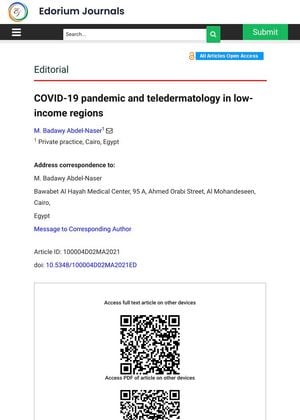COVID-19 Pandemic and Teledermatology in Low-Income Regions
September 2021
alopecia telogen effluvium alopecia areata androgenic alopecia xeroderma generalized pruritus hyperhidrosis hyperpigmentation acne rosacea atopic dermatitis psoriasis seborrheic dermatitis vitiligo chronic urticaria maculopapular rashes vasculitis urticaria vesicular rashes erythema multiforme chilblain-like lesions hair loss dry skin itchy skin excessive sweating dark spots pimples redness eczema scaly skin dandruff white patches hives red rashes blisters red patches

TLDR The COVID-19 pandemic increased the use of teledermatology to treat skin conditions in low-income areas, despite challenges like poor photo quality.
The COVID-19 pandemic has limited patients' access to healthcare facilities, leading to the rise of teledermatology as a practical tool for providing medical services for mild cases, especially in low-income regions. Despite the challenge of poor quality photos provided by patients, this has offered dermatologists an opportunity to gain experience in making diagnoses from such images. The pandemic has resulted in various skin diseases, including those directly related to SARS-CoV-2 infection and its variants, and those related to the implemented preventive measures. Skin diseases related to the virus include maculopapular rashes, vasculitis, urticaria, alopecia, vesicular rashes, erythema multiforme, and chilblain-like lesions. Preventive measures have also led to stress and anxiety-related psychosomatic diseases, such as telogen effluvium, xeroderma, generalized pruritus, hyperhidrosis, hyperpigmentation, and exacerbation of preexisting dermatoses like acne, alopecia areata, rosacea, atopic dermatitis, psoriasis, seborrheic dermatitis, vitiligo, and chronic urticaria.





